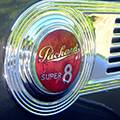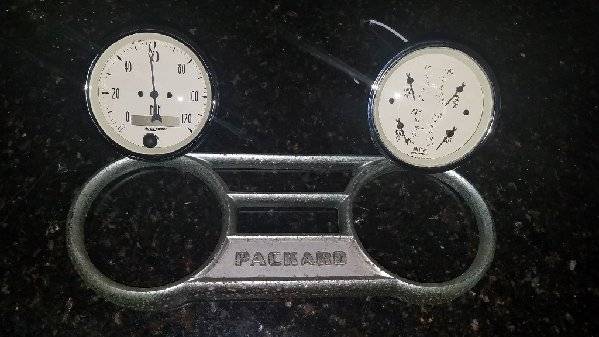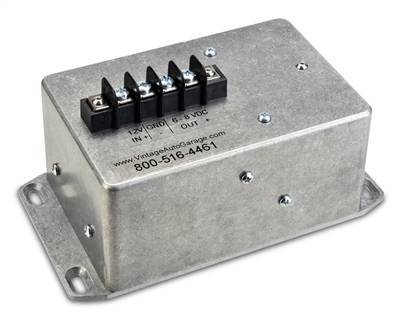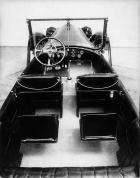|
Twelve Volt Conversions
|
||||
|---|---|---|---|---|
|
Home away from home
|
Friends
I have been spending some time on other antique car forums recently, and came across this as a link on a Model T site. I have tracked it down and it is from a large Australian website. The content is mostly vintage electronics , but has Model T content on it also. I have a hard time understanding why a 12 volt conversion is needed, it strikes me as much easier to properly maintain the car. Here is a thorough explanation of all the problems and damage of a voltage conversion. members.iinet.net.au/%7Ecool386/6or12/6or12.html Best John Harley
Posted on: 2019/5/30 6:40
|
|||
|
||||
|
Re: Twelve Volt Conversions
|
||||
|---|---|---|---|---|
|
Home away from home

|
John,
I'm pretty sure most on this site will agree with you. If a car is maintained, there's no need to convert to 12V from 6V. That said, using a trickle charger on a 6V battery when not in use is a good idea. Some recommend using a 6V Optima battery for more cranking power. And adding a small 12V converter and connecting it to the cigar lighter for 12V Negative Ground to plug in chargers for smart phones, tablets, etc. covers that aspect of needing 12V. Recent discussion on 12 volt conversion. Some pix of my setup here: packardinfo.com/xoops/html/modules/newbb ... um=1&post_id=211772#forumpost211772
Posted on: 2019/5/30 9:19
|
|||
|
||||
|
Re: Twelve Volt Conversions
|
||||
|---|---|---|---|---|
|
Home away from home

|
No question that it's preferable to maintain an original 6V system than convert to 12V. Especially on prewar cars like Packards, which contain a healthy collection of 6V electrical components (eg the overdrive). Effective conversion of these cars is actually quite difficult, and arguably not worth the trouble. Ask me how I know!
The problem arises when you inherit a car where somebody has already had (usually a half-baked) go at a 12V conversion to solve some potentially expensive problem eg poor starting or charging when the cars were "old clunkers". Nobody cared much about originality then. Just needed the car to run. I have such a car. My 1941 120 Club Coupe. When I got it it was already fitted with a 12V alternator, upgraded ignition, globes etc. The overdrive, instrument lights and clock were disconnected to protect them, presumably. So now I'm faced with trying to untangle this mess. Gave some thought to going back to 6V, but soon realised that is harder now to obtain the original components, such as a decent 6V generator, and I'd end up throwing a lot of the existing stuff away (headlights, driving lights). This is not - and never will be - a concours car so originality is not a key concern. It's nice to be able to drive it safely at night with driving lights etc without worrying about running the battery down. Keeping the car usable and out on the road is more important to me than originality. I know of many other cars which received this treatment. It's not such a simple issue for the current owners. Cheers Brian
Posted on: 2019/6/1 17:34
|
|||
|
1941 120 Club Coupe (SOLD)
1956 Clipper Deluxe (RHD and auto) - for the wife, or so I told her! |
||||
|
||||
|
Re: Twelve Volt Conversions
|
||||
|---|---|---|---|---|
|
Forum Ambassador
|
For the OD I would suggest something like this converter which is specifically motor and coil rated. If you check out their store they have several other units varying in capacity but for OD 25amp is as low as I would go. They have a 30 and a 40 amp unit which might be better as you could run a separate power supply for powering the original radio, heater and OD.
There was another vendor who had something similar but he doesn't seem to have his products available now. This converter is close in function but smaller in physical size. Unlike the other vendor I don't see where this one says specifically the units can be hooked up and work with positive ground cars. A few of the large 50 amp units on the website do say negative only but this one does not. With your alternator, possibly the car has already been polarity swapped and a moot point. If not and you are interested you might need to inquire if it will work in a positive ground car. I wouldn't be surprised if a vendor in Australia didn't have something similar.
Posted on: 2019/6/1 18:44
|
|||
|
Howard
|
||||
|
||||
|
Re: Twelve Volt Conversions
|
||||
|---|---|---|---|---|
|
Home away from home

|
As a summer project on my '49 Club Sedan, I'm converting it to 12 volt. The car is not a complete restoration but maintains the spirit of Packard with the original drive train, completely original body and interior. I need to upgrade to 12 volt to meet my driving needs.
Currently, the car has a clock that is broken, a speedometer that is broken, a windshield wiper motor that works poorly, gauges that are "directionally correct" but not accurate and taillights that even with the alternator are not as bright as current cars and are hard for some to see. The cost of getting all the old stuff fixed is equivalent to the conversion with no added benefits. The car has already been completely re-wired with an American Autowire fuse panel kit and has a 50 amp 6 volt GM alternator with dual Optima 6 volt batteries. The ignition will be converted from the current 6 volt Pertronix unit to 12 volt by changing the pickup coil in the distributor and the ignition coil. The conversion should be reasonably easy except for having to pull the dash. The new components are a set of Autometer electronic gauges and speedometer that are the exact size to fit in the dash in place of the clock and speedometer (pictured). Also a 100 amp GM 3-wire alternator is a bolt-on with the current alternator bracket. A Newport electric windshield wiper motor is a direct fit in place of the vacuum unit. The headlights will be replaced with 12 volt Halogens and the taillights with ultra bright bulbs to shine through the thick red glass. One 6 volt part that will be maintained is the 6 volt OD solenoid. I purchased a 12V to 6V OD voltage converter from Vintage Auto Garage (pictured). It's a one-piece unit that also replaces the OD relay. My long-term goal is to fit the car with air conditioning so it can be comfortably driven year round in sunny Florida. I'll place the progress on a Project Blog on one of the Packard forums.
Posted on: 2019/6/2 13:14
|
|||
|
||||
|
Re: Twelve Volt Conversions
|
||||
|---|---|---|---|---|
|
Forum Ambassador
|
Too bad that overdrive section of Vintage Auto Garage only handles R10-11 units but that is kind of to be expected because the same is true with 5th Avenue Garage's repros. That combo relay and power substitution box is kind of expensive though for being capable of only 15 amps and for such a brief period.
Packard never used the R10 but the 6v R11 stayed around for 6 years so glad there are repro parts available for those cars. The 48 and earlier R9s have no option but to use the original relays and solenoids as nothing is repro'd for them. Because of the electrical differences and added complexity, except for a modern universal kickdown switch, nothing current or specifically for an R11 will work on an R9. The R6 in a 39 and the R9 in a 40-48 will require some kind of independent power at 6v and for a margin of comfort, 20+ amps to be connected at the input fuse to the relay box just as if it were being connected to the battery in the car.
Posted on: 2019/6/2 13:54
|
|||
|
Howard
|
||||
|
||||
|
Re: Twelve Volt Conversions
|
||||
|---|---|---|---|---|
|
Home away from home

|
Howard,
Could have gone with a 12V solenoid but I have 2 spare 6V and would have had to come up with the relay mechanism of some sorts. Counting on the VAG unit to work as advertised. Here's the demo video of the VAG R10/R11 12V to 6V converter. youtube.com/watch?v=LYKOa4VCzPc
Posted on: 2019/6/2 14:48
|
|||
|
||||
|
Re: Twelve Volt Conversions
|
||||
|---|---|---|---|---|
|
Home away from home

|
Hello Howard
Thanks for the tip. That looks like a workable solution. Same seller has a 40A version which looks like a modern regulator so easy to hide. And I could hook other things like my clock to it. I'm guessing 40A would be enough for the overdrive, which I assume is peaky in power use with solenoids etc. The seller is on vacation and not taking orders so I'll try again in a couple of days. Cheers Brian
Posted on: 2019/6/2 22:11
|
|||
|
1941 120 Club Coupe (SOLD)
1956 Clipper Deluxe (RHD and auto) - for the wife, or so I told her! |
||||
|
||||
|
Re: Twelve Volt Conversions
|
||||
|---|---|---|---|---|
|
Forum Ambassador
|
40 amps is more than enough for an OD. With the excess you could set up a secondary distribution terminal and run separate wiring to each of the other items that need 6v. Some things I am still curious about on that unit and it might be good to clarify before you order is can it work on both pos and neg ground and is the case or heatsink isolated from input or output voltages so it can be mounted directly to the sheetmetal. If it can then current requirements of things you might consider supplying are:
OD is fused for 30 amps and does pull a substantial amount of that 30 for a few seconds when the solenoid is first energized and sits waiting for the internal mechanical parts to align so it can slide the pawl into position. Once the pawl is fully inserted the heavy coil is turned off leaving only a small coil energized. Current needed for the solenoid and relays then drops to a minimal amount of maybe 5 amps or so. The large changes in current requirements is what makes using an inexpensive resistor problematic. If you have an original radio, that is fused for 14 amps and probably draws a constant 10 or so. Electric windshield wipers are on a breaker around 15 amps and probably draw an average of 10 amps with more needed under a heavy load. Heaters are also fused fairly high - usually around 20 amps depending on type but generally pull half to two thirds the amount at full load. Fuel gauge probably needs around 2-3 max. Clock only has the momentary surge draw.
Posted on: 2019/6/3 8:52
|
|||
|
Howard
|
||||
|
||||

 (70.79 KB)
(70.79 KB)








